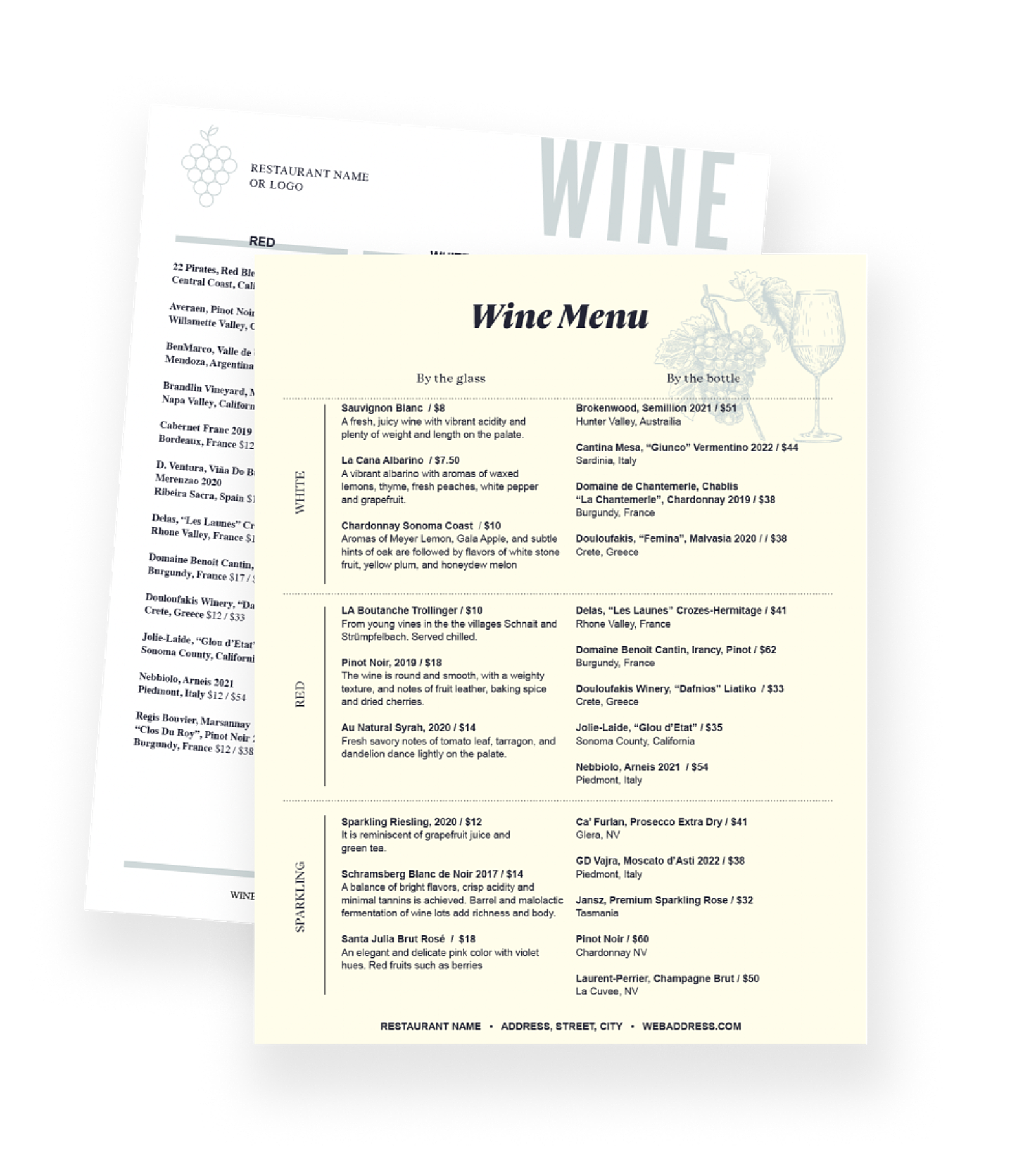
How to Open a Wine Bar: Starting a Wine Bar Checklist
Want to open a wine bar? Here’s a checklist to help you do it.

Nick PerryAuthor


Wine Menu Templates
Use these wine menu templates as a starting point for your menu design or to give your menu a refresh.
Get free downloadFor many people, opening a wine bar is a dream. But whether you’ve worked in the restaurant industry for a long time, or you’re new to it, starting a bar is a risky venture. You’ve no doubt heard that food and drink establishments frequently fail, and considering that 52% of restaurant managers report high costs being a significant operating challenge, it’s no surprise.
If you’re going to open a wine bar, you have to be thorough and determined. It’ll take money, time, and patience, as well as an ironclad plan. That’s what we’ll discuss here.
In this article, you will learn the complete step-by-step guide to opening a wine bar.
Wine Menu Templates
Use these wine menu templates as a starting point for your menu design or to give your menu a refresh.

How to Open a Wine Bar: Your Complete Checklist
Opening a wine bar takes more than an idea. It takes a lot to open a restaurant of any kind, and you’ll need a strong strategy to go from concept to opening day.
Choose your concept
Every wine bar needs a strong concept. Whether it’s a catchy name, cool branding, or an interesting theme, your bar’s concept will be the first thing that catches people’s attention. Of course, a wine bar in and of itself is the start of a concept. The next step is honing that concept. Will you specialize in Spanish wines? Will you have a deep menu of bar snacks for pairing?
Your excitement for your wine bar concept will guide you through the entire process.
Set up your business structure
One of the first major decisions you must make when starting any business is how to structure your business. You must decide to be a sole proprietorship, a partnership, an LLC, or a corporation.
These business structures impact how your business is taxed and what kind of personal liability you have around the business. While sole proprietorships and partnerships are easier to start, they leave you personally liable for lawsuits and debt incurred by the wine bar. If something goes wrong, your personal assets could be impacted.
To avoid personal liability, the best option is for you to set up your wine bar as an LLC or a corporation. These business structures act as an entity of their own and take on the business' liabilities, which limit your liability.
Write your wine bar’s business plan
Any business needs a quality business plan. Your wine bar business plan is the guiding light and source of truth for your business. It lays out the concept of your bar, how you plan to source wines, how you’ll price items to be profitable, your marketing plan, your operating plan, and much more. It’s the ultimate document that conveys to anyone on the outside how you plan to make your wine bar successful.
Figure out funding
One imporant aspect of your business plan is figuring out a budget. Your business plan will help you identify fixed and variable costs to determine an operating budget both right out of the gate, and as your wine bar begins to grow.
With this information, you’ll have a better idea of how much funding you’ll need for your business. Considering it costs between $110,000 and $850,000 to open a bar, you’ll probably need some outside help.
There are many options available to aspiring wine bar owners, from loan options for small businesses, to angel investors, to crowdfunding – learn more about how to open a bar with no money here.
Follow the legal requirements
After you’ve chosen your business structure, you’ll also need to understand the legal requirements for that type of structure and for operating a brick-and-mortar business in your preferred area.
You’ll need to set up tax identification by getting an employer identification number (EIN) through the IRS and understand all of the filing requirements for your business, especially as you hire employees. Make sure to bring in a good accountant to help you manage the finances and compliance measures because you don’t want to make an enemy of the IRS out of the gate.
Additionally, your business will need licenses and permits to operate, which won’t be the same everywhere. You’ll need a liquor license to serve wine and a variety of licenses and permits to sell food and operate in a given city.
Finally, don’t forget to get business and/or restaurant insurance. Many things could go wrong on a given night, and you want to make sure your equipment and space is protected.
Choose a location
Sure, it would be great to have a downtown location with heavy foot traffic for your wine bar, but that might not be in the cards. Spend some time location scouting to find somewhere that works for your concept, budget, and convenience.
While you may assume that leasing and renovating a space is the easiest option, it’s often not the cheapest. It’s actually often cheaper to buy an existing bar space and tailor it to your needs than it is to get into a commercial lease. The most expensive option would be to build your wine bar from the ground up, but it’s also the option that gives you the most control.
Design your layout
You probably thought a bit about your layout when you’ve imagined your wine bar’s concept, but you can’t make it a reality until you know the location.
When thinking about your wine bar’s floor plan, consider what kind of ambience you want your wine bar to have. Should it feel more exclusive or bustling? Is it quiet or rambunctious? How much of the space should the bar take up? The ambiance you want will impact the layout and design of the bar.
Remember, you may also need to leave room for tech and equipment to support your venture. Maybe you want a jukebox in one corner, or you want to give staff the capability to check customers out at multiple stations. Also, the bar must have room for all of the equipment bartenders need to do their jobs and you’ll need space to store dining utensils, cleaning supplies, and other restaurant equipment.
Build your menu
You may choose not to serve food at your wine bar, but that doesn’t mean you shouldn’t still have a menu. In fact, a wine bar should have a very well thought out menu. After all, you’re specializing in wine, so you should be prepared to offer wines you truly love, that you can talk about, and that you believe patrons will love as well. People go to wine bars to enjoy, and often learn about wine, so you’ve got a responsibility to keep the menu fresh and interesting.
Choose your suppliers and vendors
Part of building out your wine bar menu will include figuring out exactly where you can source wine and ingredients from. You may have several bar suppliers for the wine, food ingredients, restaurant supplies, menus, and more. Making great relationships with suppliers and vendors is crucial to keeping your fixed costs under control and maintaining a healthy profit margin.
Hire staff
A wine bar isn’t just any kind of bar, so you can’t just hire any kind of staff. You want to employ people who will be able to discuss the wine they’re serving and who you believe have a genuine interest in wine. As such, invest some time in your hiring process.
Really consider what you’re looking for in staff members and create interview questions that reflect who you want to work with. This will help you build you a strong staff right from the start.
Create your marketing plan
Wine bars may not be as competitive as more traditional bars, but you’ll still need a strong marketing plan to stand out from the rest of the bars in town. On one hand, being a wine bar is a marketing tool in itself. By offering something different from the rest of the bars in town, you’ve got a marketing idea right there.
Play up what makes your bar different and don’t be afraid to invest in marketing ideas like special items, promotions, and deals on different wines. Likewise, set aside some money in the budget to advertise your wine bar locally, whether it’s through paid ads online or a flyer in the local gazette.
Plan your opening
Every restaurateur has different opening strategies. You may want to have a soft opening first with just family and friends to test out the concept, iron out any of the final details, and make sure you’re ready to begin serving the public.
Otherwise, when it’s time for your grand opening, you should have a plan in place to make sure business is booming on the first day. Get the word out ahead of time through advertising, offer a fun grand opening promotion, and be ready to execute on outstanding service on opening night.
***
Opening a wine bar is an expensive, potentially risky venture. Not just that, but there’s a lot to think about logistically. This step-by-step guide should give you more transparency into the process and give you the support you need to successfully open and grow your wine bar.
Is this article helpful?
DISCLAIMER: This information is provided for general informational purposes only, and publication does not constitute an endorsement. Toast does not warrant the accuracy or completeness of any information, text, graphics, links, or other items contained within this content. Toast does not guarantee you will achieve any specific results if you follow any advice herein. It may be advisable for you to consult with a professional such as a lawyer, accountant, or business advisor for advice specific to your situation.
Read More
Subscribe to On the Line
Sign up to get industry intel, advice, tools, and honest takes from real people tackling their restaurants’ greatest challenges.



